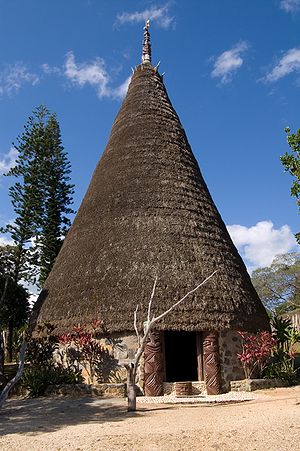
Flèche faîtière
Encyclopedia

Spire
A spire is a tapering conical or pyramidal structure on the top of a building, particularly a church tower. Etymologically, the word is derived from the Old English word spir, meaning a sprout, shoot, or stalk of grass....
or finial
Finial
The finial is an architectural device, typically carved in stone and employed decoratively to emphasize the apex of a gable or any of various distinctive ornaments at the top, end, or corner of a building or structure. Smaller finials can be used as a decorative ornament on the ends of curtain rods...
that adorns Kanak
Kanak people
Kanak are the indigenous Melanesian inhabitants of New Caledonia, an overseas territory of France in the southwest Pacific. They constitute 44.1% of the total population of New Caledonia. Though Melanesian settlement is recorded on Grande Terre's Presqu'île de Foué peninsula as far back as the...
houses, particularly the Great Houses of the Kanak Chiefs, in New Caledonia
New Caledonia
New Caledonia is a special collectivity of France located in the southwest Pacific Ocean, east of Australia and about from Metropolitan France. The archipelago, part of the Melanesia subregion, includes the main island of Grande Terre, the Loyalty Islands, the Belep archipelago, the Isle of...
. The ceremonial carving is the home of ancestral spirits and is characterized by three major components. The ancestor is symbolized by a flat, crowned face in the centre of the spear. The ancestor's voice is symbolized by a long, rounded pole that is run through by conch shells. The symbolic connection of the clan, through the chief, is a base, which is planted into the case's central pole. Sharply pointed wood pieces fan out from either end of the central area, symbolically preventing bad spirits from being able to reach the ancestor. It evokes, beyond a particular ancestor, the community of ancestors. The flèche faîtière was depicted on a 2007 New Caledonian stamp.
Etymology
Flèche is a general architectural term for "spire". It is used to define a small but tall post that is fixed at the crossing of the naveNave
In Romanesque and Gothic Christian abbey, cathedral basilica and church architecture, the nave is the central approach to the high altar, the main body of the church. "Nave" was probably suggested by the keel shape of its vaulting...
and transepts in cathedrals and large churches. ‘Flèche faîtière’ means "carved roof top spear", which adorns the 'grande case' or the "Great Hut" of the Chief of a Kanak clan.
Symbolism
The flèche faîtière is wood sculpture that represents the spirit of Kanak culture, which resembles a small totem pole. As it represented the power of the clan Chiefs of Kanaks over their subjects, it was adopted as part of the flag of the Kanaks by the organization leading the independent movement in New Caledonia. The Grand Huts also known as grande case (chef's hut) are decorated with the filial of flèche faîtière representing the ancestral spirits, symbolic of transition between the world of the dead and the world of the living.The arrow or the spear normally has a needle at the end to insert threaded shells from bottom to top; one of the shells contains arrangements to ensure protection of the house and the country. During wars enemies attacked this symbolic finial. After the death of a Kanak chief, over whose Great House the flèche faîtière is fixed, it is removed and his family takes it to their home. Though it was allowed to be used again as a sign of respect, it is normally kept at burial grounds of noted citizens or at the mounds of abandoned grand houses.
Flag
The flèche faîtière also adorns the official flag of the Kanak people. As it represented the power of the Chiefs over their subjects, it was adopted as part of the flag of the Kanaks by the organization leading the independent movement in New Caledonia. The flag of Kanaky is set in three colours namely, green for earth and flora, red for blood and sacrifice of people and blue signifying sea and sky. The solar disk with the hut inscribed, with the ridge pole in black, which is the symbolic flèche faîtière, is set in the middle of the flag. The flag representing the indigenous movement of the Kanak people was endorsed by the territorial congress to be flown alongside the National Flag of France, and the Prime Minister of France was set to hoist the Kanak flag during his visit to New Caledonia in July 2010.The indigenous Kanak flag and the French Tricolour were hoisted above the high commission in Nouméa, the capital of New Caledonia. It is one of the few countries, such as Canada
Canada
Canada is a North American country consisting of ten provinces and three territories. Located in the northern part of the continent, it extends from the Atlantic Ocean in the east to the Pacific Ocean in the west, and northward into the Arctic Ocean...
that have two national flags. However, there is a strong move now to evolve a new flag for New Caledonia which would represent elements of the "Tricolor and the Kanak flags as a common destiny".
Notable examples
The Mwa Ka is located in a landscaped square opposite the Musée de Nouvelle-Calédonie and has a 12 metre pole, topped with flèche faîtière; its carvings represent the eight customary regions of New Caledonia. The Jean-Marie Tjibaou Cultural CentreJean-Marie Tjibaou Cultural Centre
The Jean-Marie Tjibaou Cultural Centre, on the narrow Tinu Peninsula, approximately northeast of the historic centre of Nouméa, the capital of New Caledonia, celebrates the vernacular Kanak culture, the indigenous culture of New Caledonia, amidst much political controversy over the independent...
has numerous huts with flèche faîtière.

